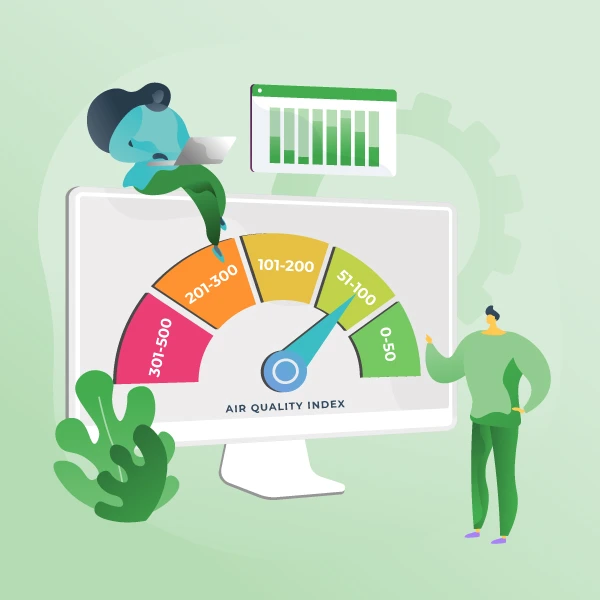Summary of Blog
As an environment-centric society, it has become increasingly paramount to understand the unseen aspects of our world that directly influence our well-being. One such major factor is the air we breathe. Air quality is a frequently understated and misunderstood topic, often hidden under the umbrella of ‘climate change’ and ‘environmental conservation’.
This blog aims to shed light on the intricacies of air quality, focusing on the six levels that denote its state and how they can impact our lives.
Identifying the Six Levels of Air Quality
As you might imagine, air quality isn’t uniform around the globe or even within a single region. Variations in pollution sources, atmospheric conditions, weather, and human activity contribute to a dynamic air shed. Scientists and environmentalists categorise air quality into six levels to effectively measure and communicate these variations.
Each level signifies a certain range of the Air Quality Index, which is globally accepted but modified according to different countries. For instance, India, Europe, etc. have their own set of AQI standards defines.
Understanding the Air Quality Index (AQI)
Before we delve into the six levels, let’s briefly understand what the AQI is. The Air Quality Index is a yardstick that runs from 0 to 500. The higher the AQI value, the greater the level of air pollution and hence, the greater the health concern.
An AQI value of 100 generally corresponds to the National Ambient Air Quality Standards (NAAQS) for the pollutant. This level is short-term exposure for the public for each pollutant.
What are the Six levels of air quality
Each level of air quality represents a range on the AQI and is associated with a different set of potential health impacts. The levels range from ‘Good’, signifying little or no risk, to ‘Hazardous’, where serious health effects are a widespread risk.
Level 1: Good Air Quality (0 - 50)
This level represents the epitome of air quality, with an AQI range from 0 to 50. At this stage, the air is clean, fresh, and predominantly free from pollutants. Individuals can freely partake in outdoor activities, including those involving high energy output like running or playing sports, without the worry of adverse health impacts. The air at this level is particularly beneficial for the elderly, children, and those with chronic health conditions, such as asthma, who are typically more sensitive to pollutants.
Nevertheless, maintaining good air quality is important not only for public health but also for the environment. High-quality air allows ecosystems to thrive, contributing to biodiversity and the health of the planet.
The challenge for societies worldwide is to minimise pollutant emissions via sustainable practices and clean energy solutions to ensure ‘Good’ air quality becomes the norm and not the exception.
Level 2: Moderate Air Quality (51 - 100)
An AQI between 51 and 100 is deemed ‘Moderate’. The air quality at this level is generally acceptable; however, certain pollutants might present a moderate health concern for an extremely small number of people who are unusually sensitive to air pollution. For instance, those with respiratory conditions may experience mild symptoms, such as coughing or shortness of breath.
However, for the vast majority of the population, the ‘Moderate’ level does not impose significant health risks. It is a level that typically signifies normal urban air quality where common pollutants like particulate matter from traffic and industry are present but not at concentrations high enough to cause harm to the general public.
Level 3: Unhealthy for Sensitive Groups ( 101 - 150)
Once the AQI value ascends to between 101 and 150, we reach the ‘Unhealthy for Sensitive Groups’ level. Here, sensitive individuals, including children, the elderly, and those with underlying health conditions, especially respiratory and cardiac problems, may start to experience health effects.
In this range, sensitive individuals should limit their outdoor activities and ensure they have their medication readily available if needed.
Even though the general public might not feel the effects, it is still essential to stay informed and be aware of the air quality. It also underlines the necessity for cities to enact effective pollution reduction strategies.
Level 4: Unhealthy Air Quality ( 151 - 200)
At this stage, everyone, regardless of their health condition, may start to experience adverse health effects. Symptoms can range from eye irritation and coughing to more serious concerns, such as aggravated heart and lung diseases leading to increased hospital admissions. As a result, everyone, especially sensitive groups, are advised to limit prolonged outdoor exertion.
Furthermore, this stage serves as a strong wake-up call for regions consistently experiencing such air quality, emphasising the urgency to tackle pollution sources and improve air quality for residents’ health.
Level 5: Very Unhealthy Air Quality ( 201 - 300)
‘Very Unhealthy’ is an AQI level ranging between 201 and 300, where health warnings of emergency conditions come into effect.
The air is harmful to breathe, and the entire population is more likely to be affected by severe health effects, such as difficulty in breathing and severe asthma attacks. Even healthy individuals might suffer from respiratory symptoms and should significantly limit their outdoor activities.
In such situations, it’s not just the individual’s health at risk but the community’s health as a whole. It’s a call to action for governmental bodies and organisations to implement stringent measures to combat pollution.
Level 6: Hazardous Air Quality ( 300+)
The highest level of risk is ‘Hazardous’, where the AQI exceeds 300. This level presents dire health warnings of emergency conditions. Everyone is susceptible to more severe health effects, and staying indoors becomes a necessity.
Medical facilities may experience an unprecedented surge in respiratory and cardiovascular complications admissions.
This stage emphasises the extreme consequences of poor air quality management and the detrimental impact of unsustainable practices on public health. It serves as a reminder that efficient and effective environmental management is pivotal to ensuring the health and well-being of all residents.
Factors Influencing Air Quality
Numerous factors influence air quality, including both natural and anthropogenic (human-made) sources. Natural sources include dust, pollen, forest fires, and volcanic activity. Anthropogenic sources range from industry emissions and vehicle exhausts to household heating and cooking.
Weather patterns and geographical features can also significantly impact air quality, affecting how pollutants are dispersed and diluted.
Monitoring and Measuring Air Quality
Understanding and addressing the challenges of air quality begins with monitoring. Monitoring air quality is a complex process that requires advanced technological tools. Oizom, a leading environmental monitoring solution company, offers reliable and advanced air pollution monitor that provide real-time, high-resolution data on various air pollutants. Their innovative solutions, including the Oizom Polludrone, utilise IoT (Internet of Things) technology and artificial intelligence to collect and analyse air quality data.
Check out Oizom’s advanced solutions for odours monitoring system improving air quality management today.
Mitigation and Improvement Measures
Improving air quality requires a multifaceted approach, which includes stricter regulations on pollutant emissions, cleaner methods of energy production, and changes in individual behaviour, such as using public transport or adopting electric vehicles. Technological innovations in air filtration, purification, and carbon capture and storage are also crucial in combating air pollution.
Conclusion
The quality of the air we breathe directly influences our health and well-being. Understanding the six levels of air quality, and the factors that contribute to these levels, is key to driving improvements and taking protective measures where necessary. Monitoring air quality with tools such as those provided by Oizom plays a pivotal role in raising awareness and guiding policy-making for environmental protection. Real-world initiatives like London’s ULEZ offer valuable insights into how urban air improvement strategies can make a measurable difference, reinforcing the importance of continuous air quality monitoring and action.
Frequently Asked Questions (FAQs)
The primary sources of air pollution are motor vehicles, industry and power generation, and residential heating and cooking. Natural events such as forest fires and volcanic eruptions also contribute to air pollution.
Poor air quality can cause a range of health problems, from minor irritations such as coughing and eye irritation to serious conditions, including heart disease and lung cancer.
Yes, air quality can vary significantly within a city due to pollutant sources, weather, and geography variations. Urban planning and monitoring are, therefore, essential in managing air quality at a local level.
Urban areas typically have poorer air quality due to higher concentrations of pollutant sources. However, rural areas can also experience poor air quality due to factors such as agricultural burning and wind-blown dust.
Long-term exposure to hazardous air quality can lead to chronic respiratory and cardiovascular diseases, lung cancer, and even premature death.
To learn more about air quality and how to monitor it effectively, visit Oizom, or get in touch with our team to discuss how their solutions can benefit you and your community.






